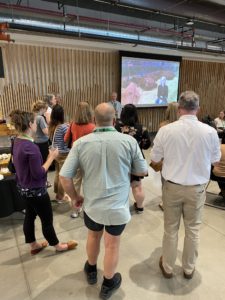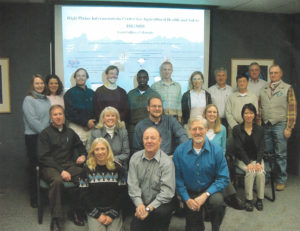
With Colorado’s summer harvest season wrapping up, chances are that you’ve enjoyed one of our state’s summer staple foods: Palisade Peaches, Rocky Ford Melons, Pueblo Chiles and Olathe Sweet Corn. Along with well-known quality livestock, dairy and grains, these regional favorites make it from fields and pastures to our tables thanks to the 195,000 people employed by Colorado’s agricultural industry.

One of the most dangerous occupations in the United States, farm and ranch workers are exposed to extreme weather, long workdays, heavy machinery, and other unique workplace hazards in order to produce the food that sustains the region. Since 1991, CSU researchers at the High Plains Intermountain Center for Agricultural Health and Safety have been working to better understand these hazards and design and test interventions to improve safety.
Founded by late CSU Professor of Environmental and Radiological Health Sciences, Roy Buchan, and Professor Emerita in the CSU School of Social Work, Vicky Buchan, the center celebrated its 30th anniversary earlier this year. “Perhaps the most fundamental activity in any society is food production” wrote Roy Buchan in the center’s very first annual report. “[We are] dedicated to the improvement of the health, safety and wellbeing of the residents of Colorado, the high plains, and the Rocky Mountain Region.”
Legacy of impactful research
The center has held continuous funding from the National Institute for Occupational Safety and Health, a branch of the Centers for Disease Control and Prevention, throughout its 30 years of work. After initial funding in 1991, they have successfully competed for and been awarded additional funding six times, most recently in 2022. The center’s research support to date is more than $28.5 million dollars, with an additional $7.8 million in the next five years.

For the last 20 years, Stephen Reynolds, professor of environmental and radiological health sciences, has been the center’s director. “Building and maintaining relationships has been key to our success,” said Reynolds. “Cultivating trust allows us to hear about emerging threats sooner and explore practical solutions on farms in real-time.” Among its most recent success, the center has supported COVID-19 vaccine clinics and education and published a workplace safety manual distributed to dairy farms nationwide.
“To receive continuous funding for 30 years is exceptional” said Lorann Stallones, center deputy director and professor of psychology. “It reflects CSU’s leadership in the field of agricultural occupational safety and health and the robust partnerships we have built within the university and across the region and the world. These partnerships enhance our ability to recognize and respond to changes in agricultural production using innovative approaches.”
Dedication to transdisciplinary collaboration

A core tenant of the center’s work is transdisciplinary collaboration. Though administratively managed in the Department of Environmental and Radiological Health Sciences in the College of Veterinary Medicine and Biomedical Sciences, the center’s projects have been led by researchers from CSU’s College of Agricultural Sciences, College of Health and Human Sciences, College of Liberal Arts, College of Natural Sciences, the Walter Scott, Jr. College of Engineering, as well as at colleges and universities in California, Texas, Tennessee and Utah.
“Through the center, I’ve been able to work with psychologists, anthropologists, and sociologists,” said Dr. Noa Román-Muñiz, professor and director of undergraduate programs in the Department of Animal Sciences. “I have come to understand that my work as an animal scientist and veterinarian is incomplete if I don’t look at the social sciences. If I don’t look at all the factors that are affecting human behavior, the people caring for cows, I’m really not being effective in keeping cows healthy.”
Looking to the future
With renewed funding beginning this fall, the center’s administration, evaluation, outreach, and small grant programs will continue at CSU. They also received funding for two large and two small research projects that respond to regional needs:
- Dairy Worker Fatigue Assessment and Influence on Health, Safety and Performance
Principal Investigator: David Douphrate, Texas A&M University, 2022-2027 - Agricultural Safety Training through Emergency Preparedness: One Community Collaborative
Principal Investigator: Michael Pate, Utah State University, 2022-2027 - Bridging Differences Between Faith and Behavioral Health Professionals: Using Intergroup Dialogue to Improve Agricultural Mental Health Systems
Principal Investigator: Annie Keeney, San Diego State University, 2022-2025 - HoPE: Home Pesticide Exposure Kit
Principal Investigator: Chuck Henry, Colorado State University, 2025-2027
“The COVID-19 pandemic really highlighted the need for innovative, well-coordinated and interdisciplinary approaches to prevent workplace injuries and deaths” said Reynolds. “These are our strengths already. I’m excited to apply them to our new projects and expand our impact across Colorado and beyond.”